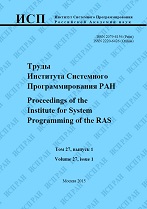|
Data-oriented scheduling with dynamic-clustering fault-tolerant technique for scientific workflows in clouds
Z. Ahmad, A. I. Jehangiri, M. Iftikhar, A. I. Umer, I. Afzal
Hazara University
Abstract:
Cloud computing is one of the most prominent parallel and distributed computing paradigm. It is used for providing solution to a huge number of scientific and business applications. Large scale scientific applications which are structured as scientific workflows are evaluated through cloud computing. Scientific workflows are data-intensive applications, as a single scientific workflow may consist of hundred thousands of tasks. Task failures, deadline constraints, budget constraints and improper management of tasks can also instigate inconvenience. Therefore, provision of fault-tolerant techniques with data-oriented scheduling is an important approach for execution of scientific workflows in Cloud computing. Accordingly, we have presented enhanced data-oriented scheduling with Dynamic-clustering fault-tolerant technique (EDS-DC) for execution of scientific workflows in Cloud computing. We have presented data-oriented scheduling as a proposed scheduling technique. We have also equipped EDS-DC with Dynamic-clustering fault-tolerant technique. To know the effectiveness of EDS-DC, we compared its results with three well-known enhanced heuristic scheduling policies referred to as: (a) MCT-DC, (b) Max-min-DC, and (c) Min-min-DC. We considered scientific workflow of CyberShake as a case study, because it contains most of the characteristics of scientific workflows such as integration, disintegration, parallelism, and pipelining. The results show that EDS-DC reduced make-span of 10.9% as compared to MCT-DC, 13.7% as compared to Max-min-DC, and 6.4% as compared to Min-min-DC scheduling policies. Similarly, EDS-DC reduced the cost of 4% as compared to MCT-DC, 5.6% as compared to Max-min-DC, and 1.5% as compared to Min-min-DC scheduling policies. These results in respect of make-span and cost are highly significant for EDS-DC as compared with above referred three scheduling policies. The SLA is not violated for EDS-DC in respect of time and cost constraints, while it is violated number of times for MCT-DC, Max-min-DC, and Min-min-DC scheduling techniques.
Keywords:
scientific workflows, fault-tolerant, workflows scheduling, cybershake, data-oriented.
Citation:
Z. Ahmad, A. I. Jehangiri, M. Iftikhar, A. I. Umer, I. Afzal, “Data-oriented scheduling with dynamic-clustering fault-tolerant technique for scientific workflows in clouds”, Proceedings of ISP RAS, 31:2 (2019), 121–136
Linking options:
https://www.mathnet.ru/eng/tisp413 https://www.mathnet.ru/eng/tisp/v31/i2/p121
|

| Statistics & downloads: |
| Abstract page: | 107 | | Full-text PDF : | 19 | | References: | 12 |
|




 Contact us:
Contact us: Terms of Use
Terms of Use
 Registration to the website
Registration to the website Logotypes
Logotypes








 Citation in format
Citation in format 